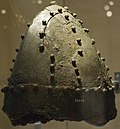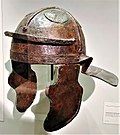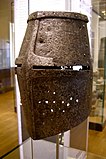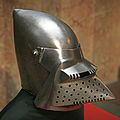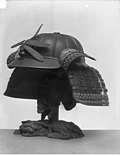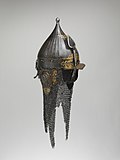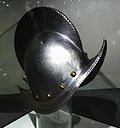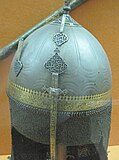Ancient militaries
[edit]-
Mycenaean Greek boar tusk helmet, Mycenae, 14th century BCE
-
Persian helmet (Sassanid army)
-
Roman legionary helmet - galea
-
Ancient Chinese helmet from the Zhou dynasty
-
Imperial Chinese helmet from the Northern and Southern dynasties period
| Model | Origin | Users |
|---|---|---|
| Attic helmet | ancient Greeks | |
| Boar's tusk helmet | 17th century BCE | Mycenaean Greeks until the 10th century BCE |
| Boeotian helmet | ancient Greek cavalry | |
| Chalcidian helmet | ancient Greeks | |
| Coolus helmet | ancient Romans | |
| Corinthian helmet[1] | ancient Greeks | |
| Disc and stud helmet | c. 400 BCE | ancient Illyrians & Adriatic Veneti until 167 BCE |
| Galea (helmet) | ancient Romans | |
| Horned helmet | c. 1000 BCE | Celtic Europeans until 700 CE |
| Illyrian type helmet | ancient Greeks | |
| Imperial helmet | 1st century CE onwards | Roman Empire |
| Imperial Chinese helmet | 1st century CE | imperial Chinese dynasties |
| Kegelhelm | ancient Greeks | |
| Negau helmet | ancient Etruscans in Negau, Slovenia | |
| Montefortino helmet | ancient Romans | |
| Pilos | ancient Greeks | |
| Pot helmet | ancient Illyrians | |
| Phrygian/Thracian helmet | 5th century BCE | ancient Greeks in Thrace, Dacia, Italia & Hellenistic Europe until c. 200 CE |
| Zhou helmet | 7th century BCE | ancient Chinese in Zhou dynasty |
Medieval and early modern
[edit]-
6th century Spangenhelm.
-
Eastern European conical helmet from the 11th century
-
German great helm of the 12th or 13th century.
-
Italian bascinet from about 1400.
-
English sallet of the 15th century.
-
16th century Ottoman Zischagge.
-
French morion helmet, 17th century.
-
"Indian Helmet, Shield and Swords," a print by Day and Sons, London, c. 1858
-
An early 19th century French officer's dragoon helmet.
-
17th century Safavid helmet (Safavid army).
| Model | Origin | Users |
|---|---|---|
| Armet | 15th century | Western Europeans. |
| Barbute | 15th century | Italian states. |
| Bascinet | c. 1300 | Europeans |
| Burgonet[2] | c. 1600 | Europeans, especially by militias of Poland & Switzerland |
| Lobster-tailed pot Capeline zischägge |
late 16th century | Europeans during the 17th century, including the English Civil War in England & Thirty Years' War across the Holy Roman Empire |
| Cervelliere | late 13th century | Christian Europeans in Crusades during the 14th century |
| Close helmet | late 15th century | Western Europeans. |
| Dragoon helmet | late 18th century | France. |
| Enclosed helmet | late 12th century | Western Europeans. |
| Frog-mouth helm | c. 1600 | Europeans. |
| Great helm[3] | 1189 | Europeans |
| Hounskull | 14th century | Europeans. |
| Kabuto | c. 1600 | Samurai especially during the 17th century of the Edo-period Tokugawa shogunate in Medieval Japan. |
| Kettle hat | 12th century | Common all over medieval Europe. |
| Morion | 16th and early 17th centuries | Europeans (esp. associated with Spanish Conquistadores) |
| Nasal helmet | Early Middle Ages | Byzantine Empire, later common all over Europe. |
| Pickelhaube[4][5] | 1842 | especially by Prussia & German Empire and other Europeans until 1918 |
| Raupenhelm | c. 1800–1870 | High crested leather helmet used primarily by Kingdom of Bavaria and Kingdom of Württemberg |
| Sallet | c. 1450 | Europeans |
| Secrete | 17th century | Western Europeans |
| Spangenhelm[6] | 5th century | Central Asia, Near East & Europe; espec. by Scythians, Sarmatians, Persians, & Germans until 1000 |
| Tarleton | c. 1770–1800 | Crested, peaked leather helmet used by cavalry and light infantry and British Royal Horse Artillery, France and United States in the late 18th and early 19th centuries |
| Turban helmet | 14th century | Ottoman Empire |
| Qing parade helmet | after 1655 till 1911 | China |
| Zischagge | c. 1600–1780 | Originated in the Ottoman Empire; used throughout Europe |
See also headgear listing within Components of medieval armour.
1914–1980
[edit]| Model | Image | Origins | First issued | Users |
|---|---|---|---|---|
| Adrian helmet |  |
France | 1915, 1926 | France, Belgium, Russian Empire, Poland, Japan Imperial Japanese Navy Land Forces, Kingdom of Serbia, Kingdom of Yugoslavia, U.S., USSR, Irish Free State, Kingdom of Italy, Republic of China, Manchukuo, Peru, Finland, Romania, Mexico, Greece, Uruguay, Thailand, Brazil[7] |
| Modèle 1951 |  |
France | 1951 | France, South Vietnam, South Africa, Cambodia, Laos, Lebanon, Israel, Portugal, Rhodesia |
| Modèle 1978 |  |
France | 1978 | France, Senegal |
| Brodie helmet |  |
UK | 1915, 1938 | UK, Canada, U.S. (1917–1942), Australia,[8] Republic of China, Pakistan, Poland (Polish Armed Forces in the West), Estonia, New Zealand, Sri Lanka, South Africa, India, the Netherlands, Portugal, Luxembourg, Philippines |
| Zuckerman helmet |  |
UK | 1940 | "Civilian Protective Helmet" |
| Helmet Steel Airborne Troop |  |
UK | 1941 | UK, Canada, Poland (Polish Armed Forces in the West), Belgium, Rhodesia |
| RAC helmet | UK | 1941 | armoured vehicle crews: UK, Canada, Poland (Polish Armed Forces in the West), Belgium | |
| Mk III "Turtle" helmet |  |
UK | 1944 | UK, Canada |
| Mk IV helmet |  |
UK | 1945 | UK, Canada |
| Stahlhelm[4][5] |  |
German Empire | 1916, 1917, 1918 | German Empire, Weimar Republic, Nazi Germany, Irish Free State, Poland, Estonia, Latvia, Lithuania, Finland |
| Stahlhelm M16 |  |
Austria-Hungary | 1916 | Austria-Hungary, German Empire, Weimar Republic, Poland, Austria, Nazi Germany, Finland |
| Stahlhelm M18 (Armoured warfare) |  |
German Empire | 1918 | German Empire, Turkey, Weimar Republic |
| Stahlhelm M18 (Telephone and cavalry helmet) |  |
German Empire | 1918 | German Empire, Weimar Republic, Nazi Germany |
| Stahlhelm M35 |  |
Nazi Germany | 1935 | Nazi Germany, Republic of China, China, Argentina, Chile, Colombia, Bolivia, Mexico, Estonia, Latvia, Lithuania, Poland (Home Army) |
| Stahlhelm M40 |  |
Nazi Germany | 1940 | Nazi Germany, Finland, Estonia, Latvia, Lithuania, Poland (Home Army) |
| Stahlhelm M42 |  |
Nazi Germany | 1942 | Nazi Germany, Hungary, Finland, Estonia, Latvia, Lithuania, Poland (Home Army) |
| Italian M16 Lippmann helmet |  |
Italy | 1916 | Italy, Spain |
| M31 helmet |  |
Italy | 1931 | Italy, |
| M33 helmet |  |
Italy | 1934 | Italy, Finland, |
| Greek M1934/39 (helmet) |  |
Italy | 1939 | Greece, Bulgaria |
| M42 helmet |  |
Italy | 1942 | Italy |
| M1917 helmet |  |
U.S. | 1917 | US, Philippines |
| M1 helmet |  |
U.S. | 1941 | USA, Mexico, Canada,[9]
Austria, Belgium, Czechoslovakia, Denmark, West Germany (1956-1992), Greece, Netherlands, Norway, Pakistan, Poland, Spain, Turkey, Republic of China, Egypt, Iran, Iraq, South Korea, Philippines (1944–1991), Singapore, Saudi Arabia, Thailand, Australia, New Zealand, Guatemala, Argentina, Brazil, Chile, Peru, Venezuela, Uruguay, South Vietnam |
| Swiss M1918, Swiss M1918/40 |
 |
Switzerland | 1918 | Switzerland, Argentina |
| Swiss M1971 |  |
Switzerland | 1971 | Switzerland |
| Danish M1923 helmet |  |
Denmark | 1923 | Denmark |
| Belgian M26/32 | Belgium | 1926 | Belgium, Luxembourg | |
| Swedish M1926 |  |
Sweden | 1926 | Sweden, Finland, Norway |
| Swedish M1937 |  |
Sweden | 1937 | Sweden, Finland, Denmark, Estonia |
| Spanish M1921 |  |
Spain | 1926 (?) | Spain |
| Spanish M1926 |  |
Spain | 1930 (?) | Spain |
| Spanish M1934 |  |
Spain | ? | Spain |
| M1942 Modelo Z |  |
Spain | ? | Spain |
| M1942/79 Modelo Z | Spain | ? | Spain | |
| Netherlands M23/27, Netherlands M34 |  |
Netherlands | 1928 | Netherlands, Romania |
| Hełm wz. 28 |  |
Poland | 1928 | Poland |
| Hełm wz. 30 |  |
Poland | 1930 | Poland |
| Hełm wz. 31 |  |
Poland | 1931 | Poland, Nazi Germany, Soviet Union, Finland |
| Hełm wz. 31/50 |  |
Poland | 1945 | Poland |
| Hełm wz. 50 |  |
Poland | 1950 | Poland, Albania, Egypt, Syria, Iraq, North Vietnam, Israel, Croatia |
| Hełm wz. 63 (Paratrooper helmet) |  |
Poland | 1963 | Poland, East Germany, Iraq |
| Hełm wz. 64 |  |
Poland | 1964 | Poland |
| Hełm wz. 65 |  |
Poland | 1964 | Poland |
| Hełm wz. 67 |  |
Poland | 1967 | Poland, Egypt, Ukraine, Syria, Afghanistan |
| Hełm wz. 70 |  |
Poland | 1967 | Poland |
| Irish M1928 | Ireland | 1928 | Ireland | |
| Norwegian M31 |  |
Sweden | 1931 | Norway |
| Type 90 (also called: Type 30–32, Type 92) |  |
Japan | 1931 | Japan, Thailand, China |
| Type 66 |  |
Japan | 1966 | Variant of M1 Helmet used by some elements of the JSDF Ground Forces |
| Czechoslovakian M32 helmet |  |
Czechoslovakia | 1932 | Czechoslovakia, Nazi Germany, Protectorate of Bohemia and Moravia, Slovak Republic, Finland |
| Czechoslovakian M53 helmet |  |
Czechoslovakia | 1953 | Czechoslovakia |
| Hungarian M35 | Hungary | 1935 | Hungary | |
| Hungarian M38 |  |
Hungary | 1938 | Hungary, Finland |
| Hungarian M50 |  |
Hungary | 1950 | Hungary |
| Hungarian M70 |  |
Hungary | 1970 | Hungary |
| SSh-36 |  |
Soviet Union | 1936 | Soviet Union |
| SSh-39 |  |
Soviet Union | 1939 | Soviet Union, Poland |
| SSh-40 |  |
Soviet Union | 1940 | Soviet Union (Warsaw Pact), Poland, People's Republic of China, North Korea, North Vietnam, Finland, Afghanistan |
| SSh-60 |  |
Soviet Union | 1960 | Soviet Union (Warsaw Pact), Afghanistan |
| SSh-68 |  |
Soviet Union | 1968 | Soviet Union (Warsaw Pact), Afghanistan, Syria (Russian army, Afghanistan Army, Armenian Army, Azerbaijan Army, Belarus Army, Georgia Army, Moldova Army, Nicaragua Army, Philippines (Army reservists), Syrian Army, Ukraine Army, Uzbekistan Army, Vietnam Army) |
| Bulgarian M36 helmet |  |
Bulgaria | 1936 | Bulgaria[10] |
| Portuguese M1940 | Portugal | 1940 | Portugal | |
| M42 Duperite helmet (Paratrooper helmet) |  |
Australia | 1942 | Australia |
| Mº 44 E.T.A. de Paracaidista used by Argentine Paratroopers | Argentina | 1944 | Argentina | |
| M63 Staaldak | South Africa | 1963 | Rhodesia, South Africa | |
| US Navy Mk II talker helmet |  |
U.S. | 1942 | US |
1980–present
[edit]| Model | Image | Origins | First Issued | Users | Notes |
|---|---|---|---|---|---|
| 6B26 | Russia | 2006 | Russian Armed Forces | Part of Ratnik infantry system | |
| 6B27 |  |
Russia | 2006 | Russian Armed Forces | Part of Ratnik infantry system |
| 6B28 |  |
Russia | 2006 | Russian Airborne Forces | Part of Ratnik infantry system |
| 6B47 | 
|
Russia | 2013 | Russian Armed Forces, Syrian Army[11] | Part of Ratnik infantry system |
| 6B7 |  |
Russia | 1998 | Russian Army, Syrian Army | This helmet and its variants are the standard-issue headgear of the Russian army, they also are replacing older helmets like the SSh-68; Part of Ratnik infantry system |
| 6B7-1L | Russia | Russian Army and Russian Navy naval infantry | part of Ratnik infantry system | ||
| Advanced Combat Helmet (ACH) |  |
United States | 2002 | US Army | Developed from the Modular Integrated Communications Helmet[12][13][14] |
| ASELSAN ZAMBAK | Turkey | 2012 | Turkish Armed Forces and Gendarmerie General Command | ||
| BH A-140/150 | Pakistan | Pakistan Armed Forces | GIDS ballistic helmets. BH A-140 is 1.36kg while BH A -150 is 1.50kg in weight.[15] | ||
| BK-3 Helmet | Croatia | Croatian Army, Swedish Army, German Army, Kuwaiti Army, French Army, Singapore Army, Israel Army, Saudi Arabian Army, Polish Armed Forces, Australian Army, Turkish Armed Forces, Czech Army, Bulgarian Army, United Arab Emirates Army, Lithuanian Armed Forces, Mexican Army, Spanish Army, Pakistan Army, Malaysian Army, Saudi Arabian Army, Finnish Army, National Army of Colombia, Armed Forces of the Republic of Kazakhstan, Indonesian Army, Italian Army, Military of Hungary, Armed Forces of the Argentine Republic, People's Liberation Army and by the police forces of the following countries: Croatia, Turkey, UK, Spain, North Macedonia, Egypt, Russia, Saudi Arabia, Turkey, Colombia, Italy, Ukraine, by Argentina and by the UN demining committee.[16] | Gefechtshelm M92-style helmet produced by Šestan-Busch made from Aramid fibre, with antiballistic protection level IIIA according to NIJ 0106.01 and antiballistic protection v50≥ 650 m/s according to STANAG 2920.[17] As with the German M92, the BK-3 comes with a three-point chin strap. The BK-3 replaced the Šestan-Busch BK-9 which was the first Croatian version of the Gefechtshelm M92 except it used the original US PASGT suspension head system.[18] | ||
| BK-6 | Mexico | Mexican Army | Kevlar helmet, adopted in the 2000s (decade). used in conjunction supplementation role with the PASGT. – Imported helmet. | ||
| BK-ACH Helmet | Croatia | Croatian Army | ACH shape helmet produced by Šestan-Busch, alternative to BK-3 | ||
| CABAL II | Argentina | Argentine Army Infantry | PASGT style ballistic helmet M-6 for Argentine Infantry Approved by CITEFA NIJ Level II according to the standards currently in stage R3B certified to MIL-Std 662 E.[19] However it wasn't issued in large scales. | ||
| Capacete Combate Ballistico (CCB) | Brazil | Brazilian Armed Forces | US PASGT-shape helmet in two versions: Polymer and Kevlar.[20] | ||
| CG634 |  |
Canada | 1997 | Canadian Forces | Canadian variant of the French Gallet F2 SPECTRA helmet similar to the US Military MICH 2000/ACH helmet (in that it has no peak) but with the US PASGT/French F2 helmet suspension system. Issued in 1997.[21][22][23] |
| Cobra Plus Combat Helmet | United States | 2013 | Danish Army[24] and British Forces[25] | ||
| Enhanced Combat Helmet (Australia) | Israel | 2004 (Australia) 2009 (NZ) |
Australian Defence Force, New Zealand Defence Force | The RBH 303AU model was made specially for the ADF, replacing the M91 PASGT helmet. MICH 2000 style helmet made by Rabintex, Israel[26] Was adopted by NZDF from 2009 to 2019 | |
| Enhanced Combat Helmet (ECH) |  |
United States. | 2012 | Designed as an upgrade to the Advanced Combat Helmet. Uses thermoplastics instead of ballistic fibers. | |
| EXFIL Ballistic Helmet | United States | 2016 | Australian Defence Force[27][28] | Tiered Combat Helmet (TCH) forms part of the Soldier Combat Ensemble and includes a unique rail system and a night vision mount.[29] | |
| Gefechtshelm Schuberth B826 (M92) |  |
Germany | 1992 | Bundeswehr, Austrian Federal Police,[30] Bahrain Defence Force M1 helmet-based suspension system.,[31] Belgian military,[32] Czech Army under license as the Petris P-3001,[33] Danish Army,[34] Dutch Army,[35][36] Estonian Defence Forces, Norwegian Army,[37] Swiss Armed Forces | PASGT type helmet with a sloping peak, rather than the defined peak of the US PASGT helmet. Has a 3-point retention strap system. |
| Gefechtshelm Schuberth B828 Airborne and B828 Tactical Cut | Germany | Limited use by the paratroops in Bundeswehr like Fallschirmjäger, Spezialisierte Kräfte des Heeres mit Erweiterter Grundbefähigung für Spezielle Operationen and Kommando Spezialkräfte (KSK) – | MICH 2000 and MICH 2001 type helmets | ||
| GK80 |  |
People's Republic of China | People's Liberation Army, Albania | ||
| GOLFO |  |
Chile | Military of Chile | Chilean PASGT-derived helmet. The helmet is locally made by Baselli Hermanos S.A of kevlar and was introduced in 2000. It is capable of stopping a 9×19mm round at 310m. | |
| Hełm wz. 2005 |  |
Poland | 2005 | Polish Armed Forces, Armed Forces of Ukraine | Supplementing the older Helm wz. 93 currently in use. PASGT-type helmet. The 2005 version, made by MASKPOL, came with a 4-point chin strap. The earlier Helm Wz.2000 helmet came with a 3-point chin strap. The peak of the helmet is closer to the original US PASGT helmet than other European variants in that the peak has more of the lip of the PASGT than the European-style sloping peak.[38] |
| Hełm wz. 2000 |  |
Poland | 2000 | Polish Armed Forces, Armed Forces of Ukraine | |
| Hełm wz. 93 |  |
Poland | 1993 | Polish Armed Forces, Armed Forces of Ukraine, Armed Forces of Armenia | Being replaced by the Helm wz. 2005.[39] |
| Hjälm 90 |  |
Sweden | Swedish Armed Forces | ||
| Hjelm Cato | Norway | Early 2000s | Norwegian Armed Forces | Similar to the Swedish Hjalm 90. | |
| Integrated Head Protection System | 
|
United States | 2019 | US Army | Part of the U.S. Army Soldier Protection System (SPS) |
| KASDA | Israel | Israel Defense Forces, Guatemalan Army | |||
| Kyung Chang Industry (KCI) | South Korea | Republic of Korea Armed Forces | PASGT type helmet | ||
| Kolpak 2 | Russia | Russian Army | |||
| Lightweight Helmet (LWH) |  |
United States | United States Marine Corps[40] | PASGT-style helmet with four-point retention strap system and velcro-attached head pad system. Also used by NZDF since the 2000s. | |
| LShZ 1+ | 
|
Russia | 2012 | Russian Special Forces, FSB, Syrian Army | |
| M02 Composite Helmet | Finland | Finnish Defence Forces | Upgraded PASGT-style helmet, replacing the Gefechtshelm M92-style M/92 Komposiittikypärä helmet. | ||
| M76 paratrooper helmet | United Kingdom | 1976 | British Armed forces Paratroopers and Airborne units | ||
| M80 Helmet |  |
Iraq | 1980 | Iraqi Army | Plastic and cloth copy of the M1 Helmet, Developed during Saddam Hussein's Iraq, Limited use on the modern Iraqi army. |
| M80/03 Helmet | Iraq | 1980 | Iraqi Army | Improved and stronger variant of the M80 helmet, this version has a distinct cover | |
| M83 helmet | South Africa | 1983 | Paratroopers of the South African Army | Variant of the OR-201 helmet | |
| M87 | South Africa | 1987 | South African Army | Similar to US PASGT Kevlar helmet, replacing earlier Israeli-style helmet in use since the 1980s | |
| M90 Helmet | Iraq | Another Iraqi copy of the M1 helmet, unlike the M80 helmet the M90 helmet is composed purely of plastic | |||
| M91 helmet | Australia | Australian Defence Force. | PASGT-style kevlar helmet. Was made by RBR Armour Systems Pty Ltd (Australia) introduced 1991. The Australian PASGT helmet was identical to the US PASGT helmet with the exception of a 3-point chin strap, much like the chin strap of the German B826 Gefechsthelm. Was replaced in 2004 by the Israeli-made Australian Enhanced Combat helmet. | ||
| M/92 Komposiittikypärä (also known as K-92) | Finland | Finnish Defense Forces. | Gefechtshelm M92-style PASGT helmet but with US PASGT style suspension system.[41] Replaced in the early 2000s (decade) by the M/02. PASGT-Hjelm style blend helmet | ||
| MARTE helmet | Spain | 1985 | Spanish Armed Forces, Spanish Navy Marines | Versions I to IV, MARTE IV Kevlar helmet currently used by the Spanish Armed Forces. Similar to the PASGT. MICH type helmet replacing it in the Navy Marines. | |
| Mile Dragić M-05 | Serbia | 2005 | Serbian Special Forces | MICH type helmet[42] | |
| Mile Dragić M-97 | Serbia | 1997 | Serbian Army | PASGT type helmet[43] | |
| M91 Eurokompozit | North Macedonia | 1992 | Army of North Macedonia Police of North Macedonia |
Macedonian version of the PASGT helmet. Produced by 11 Oktomvri Eurokompozit a.d. Prilep. | |
| M89 Eurokompozit | North Macedonia | 1992 | Army of North Macedonia Police of North Macedonia |
Macedonian version of the Yugoslav M59/89 JUŠ. Produced by 11 Oktomvri Eurokompozit a.d. Prilep. | |
| Mk. 6 helmet |  |
United Kingdom | British Armed Forces.[44] | being replaced by the Mk. 7 helmet | |
| Mk. 7 helmet |  |
United Kingdom | British Armed Forces | ||
| MUKUT | India | Indian Armed Forces | Advanced Combat Helmet(ACH) type Kevlar helmet made by MKU. | ||
| MICH TC-2000 | United States | special operations – United States Army | Developed for special operations use and became the basis for the Advanced Combat Helmet | ||
| MICH TC-2001 | United States | special operations – United States Army | "High cut" version of the MICH 2000. It removes all ear protection enabling headgear to be worn | ||
| MICH TC-2002 | United States | special operations – United States Army | "Gunfighter cut",[45] which raises the area around the ears by about 1/2", allowing for a wider range of headsets to be used and roughly meeting the profile of the skateboard and whitewater helmets previously used by special forces. | ||
| MPC-1 | Slovenia | Variant of OR-201 helmet | |||
| NP Aerospace AC200/650 | Greece | Special Forces unit of the Hellenic Army, Hellenic Navy and Hellenic Air Force | – Gefechshelm type helmet. – Hellenic Army, Navy and Air Force primarily use the PASGT | ||
| Ops-Core FAST Helmet |  |
United States | 2009 | United States special operations, United States SWAT and Law Enforcement, German Bundeswehr, Norwegian Armed Forces, Australian Defence Force, Australian Federal Police and others. | |
| OR-201 |  |
Israel | 1976 | Israel Defense Forces, Some units of Special forces of Indian Army, Irish Defence Force, Lebanon (Lebanese Forces, South Lebanon Army, Hezbollah, Lebanese Army), Honduran Army, Guatemalan Army, Peruvian Army, Romanian Army, Nicaragua (National Guard and Police), Portugal (Portuguese Marine Corps), South African Defence Force, Chilean Army (1st Parachutists Battalion "Pelantaru" (1º Batallón de Paracaidistas "Pelantaru")), Sri Lanka, and other countries. | |
| Patka helmet | India | Indian Armed Forces | Indigenously built helmet. It can prevent 7.62mm AKM round | ||
| PASGT helmet |  |
United States | 1983 | United States Military, Argentine Army, Mexican Army, New Zealand Defence Force, Iraq, Costa Rica | First issued in 1983 to replace the M1 helmet. Former kevlar helmet used by the United States Army, Marine Corps, Navy. Used by the USAF, but is being phased out by the ACH[46] US Air Force.[47] Adopted by the Mexican Armed Forces in the 1990s to replace the M1 helmet. Replaced the M1 helmet of the Argentine army and modified with padded interiors. US-made PASGT helmets by UNICOR replaced the New Zealand M1 helmet in the 2000s. The NZ PASGT was a copy of the USMC Lightweight helmet in that it shares the 4-point retention system and head pad system.[48] |
| QGF02 | People's Republic of China | 1994 | People's Liberation Army | ||
| QGF03 |  |
People's Republic of China | 2005 | People's Liberation Army | |
| QGF11 | People's Republic of China | People's Liberation Army | |||
| RBH303IE | Ireland | Irish Defence Force | Variant of the Enhanced Combat Helmet (Australia) helmet made by Rabintex | ||
| Savar SVRH01 |  |
Turkey | Turkish Armed Forces and Gendarmerie General Command | Based on PASGT. | |
| Savar SVRH02 |  |
Turkey | Turkish Armed Forces and General Directorate of Security | Based on MICH. | |
| SBH 400 | Pakistan | Pakistan Armed Forces | Magnum resistant helmets produced by GIDS.[49] | ||
| Sistema Compositi SEPT-2 PLUS | Italy | Italian Armed Forces[50] | |||
| Sistema Compositi SUPERUBOTT | Italy | Special Units (particularly GIS) of the Italian Law Enforcement community[51] | |||
| F2 SPECTRA |  |
France | 1992 | Danish Army, French Army, Canadian military, Austrian Army, Bangladesh Army, Malta Army, Royal Moroccan Army, Ukrainian Ground Forces, and United Nations peacekeeping forces[52] | PASGT shape helmet produced by Gallet of France, introduced early 1990s. 'Spectra' is a brand-name of a type of resistant fibre, not the actual name of the helmet. Unlike most other European PASGT style helmets, the peak of the F2 has the same defined lip as the original US PASGT helmet, whereas other European PASGT-style helmets (such as the German M92 and the Croatian BK-3) tend to have a sloping peak. |
| STSh-81 | Soviet Union | 1981 | Titanium helmet | ||
| Type 88 Helmet |  |
Japan | JSDF | PASGT type helmet |
See also
[edit]References
[edit]- ^ "Hdt. 4.180.3". Herodotus, The Histories (ed. A. D. Godley) – via Perseus Project.
- ^ Flynt, Sean A. "The Burgonet". myArmoury.com.
- ^ "75 years – Great Helms". Archived from the original on 1 April 2011. Retrieved 18 March 2007.
- ^ a b "German-Helmets.com". Archived from the original on 13 February 2009. Retrieved 13 November 2007.
- ^ a b "German Pickelhaube Spiked Helmet Evolution Guide". www.kaisersbunker.com. Archived from the original on 13 February 2006. Retrieved 13 November 2007.
- ^ Simon Coupland, "Carolingian Arms and Armor in the Ninth Century Archived 5 December 2007 at the Wayback Machine", (accessed 10 March 2006).
- ^ Heaumes Page Archived 30 November 2006 at the Wayback Machine
- ^ "Index CEF Helmets". www.kaisersbunker.com.
- ^ "Home of the M-1 Helmet". Archived from the original on 30 October 2007.
- ^ Българските Военни Каски Archived 11 October 2007 at the Wayback Machine
- ^ "Russia Says Its 'Iron Man' Exoskeleton Suits Proved 'Very Effective' In Syrian Military Operations". Latest Asian, Middle-East, EurAsian, Indian News. 2021-08-28. Archived from the original on March 26, 2023. Retrieved 2021-11-17.
- ^ Pike, John. "Advanced Combat Helmet (ACH)". www.globalsecurity.org.
- ^ "Advanced Combat Helmet ACH".
- ^ "US Military Taking Delivery of Advanced Combat Helmets".
- ^ ":: Gids - Ballistic-Helmet ::".
- ^ "Šestan – Busch d.o.o. (Ltd)". Archived from the original on 1 September 2015. Retrieved 5 September 2015.
- ^ "BK-3 helmet | ŠESTAN BUSCH". 28 August 2020.
- ^ "Composite Helmet, Ballistic helmets, Military helmets CROATIA, CROATIAN CROAT helmet, Kevlar helmet composite helmets index".
- ^ motos, cascos para. "Cascos para Motos Cascos Nahelmets Cascos Policia". www.nahelmets.com.ar.
- ^ "O Grupo - Grupo InbraLand". Archived from the original on 18 February 2014. Retrieved 2013-11-30.
- ^ "Canadian Military Police Virtual Museum". www.mpmuseum.org.
- ^ "combat helmet upgrade,tbi,brain injury,military,charity". Operation Helmet. Archived from the original on 2006-10-09.
- ^ "Composite Helmet, Ballistic helmets, Military helmets CANADA, CANADIAN helmet, Kevlar helmet composite helmets index".
- ^ KrigerenDK (11 October 2012). "Ny standardhjelm M/12 og Multicam uniform udleveres fra januar 2013". KrigerenDK (in Danish). Retrieved 19 November 2018.
- ^ "Revision to Supply State-of-the-Art Cobra Plus Head Protection System for UK Troops". Revision Military. 14 September 2015. Archived from the original on 26 July 2019. Retrieved 19 November 2018.
- ^ "Rabintex". www.rabintex.com. Archived from the original on 15 July 2011. Retrieved 4 April 2016.
- ^ "Australian Defense Force selects Team Wendy EXFIIL Ballistic Helmet". Team Wendy (Press release). 19 December 2015. Retrieved 21 November 2019.
- ^ McLennan, Lt-Col Ben (24 March 2016). "Optimal Performance" (PDF). Army: The Soldiers' Newspaper (1369 ed.). Canberra: Department of Defence. ISSN 0729-5685. Retrieved 21 November 2019.
- ^ "Australian Dept of Defence Announce $35m Contract to Aquaterro Australian Combat Helmet (Team Wendy EXFIL) Refurbishment Program - Soldier Systems Daily". 27 July 2021. Retrieved 2022-08-15.
- ^ "Composite Helmet, Ballistic helmets, Military helmets AUSTRIA, Austrian helmet, Kevlar helmet". Gostak.co.uk. Retrieved 18 March 2019.
- ^ "Composite Helmet, Ballistic helmets, Military helmets BAHREIN helmet, Kevlar helmet composite helmets index". Gostak.co.uk. Retrieved 18 March 2019.
- ^ "Composite Helmet, Ballistic helmets, Military helmets BELGIUM, Belgian helmet, Kevlar helmet composite helmets index". Gostak.co.uk. Retrieved 18 March 2019.
- ^ "Composite Helmet, Ballistic helmets, Military helmets CZECH helmet, Kevlar helmetcomposite helmets index". Gostak.co.uk. Retrieved 18 March 2019.
- ^ "Composite Helmet, Ballistic helmets, Military helmets DENMARK, DANISH helmet, Kevlar helmet composite helmets index". Gostak.co.uk. Retrieved 18 March 2019.
- ^ "Composite Helmet, Ballistic helmets, Military helmets NETHERLANDS, HOLLAND, DUTCH helmet, Kevlar helmet". Gostak.co.uk. Retrieved 18 March 2019.
- ^ "World War Helmets – Référence de casques de 1915 à nos jours". World-war-helmets.com. Retrieved 18 March 2019.
- ^ "Composite Helmet, Ballistic helmets, Military helmets NORWAY, NORWEGIAN helmet, Kevlar helmet". Gostak.co.uk. Retrieved 18 March 2019.
- ^ "Composite Helmet, Ballistic helmets, Military helmets POLAND, POLISH helmet, Kevlar helmet".
- ^ pl:Hełm wz. 2005[circular reference]
- ^ "The Warrior". www.natick.army.mil. Archived from the original on 2 June 2013. Retrieved 13 November 2007.
- ^ "Composite Helmet, Ballistic helmets, Military helmets FINLAND, FINNISH, SUOMI helmet, Kevlar helmet composite helmets index".
- ^ www.orangeteam.biz. "Mile Dragic – Production – Helmet M-05". www.armyequipment.com. Archived from the original on 7 July 2011. Retrieved 13 January 2010.
- ^ www.orangeteam.biz. "Mile Dragic – Production – Helmet M-97". www.armyequipment.com. Archived from the original on 7 July 2011. Retrieved 13 January 2010.
- ^ PLCE and Body Armour Archived 12 October 2007 at the Wayback Machine
- ^ "Canipe Correspondence – Helmets: State of the Art Then and Now – Soldier Systems Daily". soldiersystems.net. 18 August 2012. Archived from the original on 2017-10-10. Retrieved 2017-10-10.
- ^ "USAF". Operation Helmet. Archived from the original on 15 November 2009. Retrieved 6 September 2009.
- ^ "Department of the Air Force" (PDF).
- ^ "Composite Helmet, Ballistic helmets, Military helmets NEW ZEALAND helmet, Kevlar helmet". www.gostak.co.uk.
- ^ ":: Gids - Ballistic-Helmet ::".
- ^ "Sistema Compositi SEPT-2 PLUS helmet". Archived from the original on 5 January 2009.
- ^ "Sistema Compositi SUPERUBOTT helmet". Archived from the original on 5 January 2009.
- ^ "MSA – The Safety Company – Global". www.gallet.fr. Archived from the original on 26 November 2006. Retrieved 13 November 2007.
| Individual historical helmets |
| ||||||||||||||
|---|---|---|---|---|---|---|---|---|---|---|---|---|---|---|---|
| Combat |
| ||||||||||||||
| Athletic | |||||||||||||||
| Work | |||||||||||||||
| Other | |||||||||||||||
| |||||||||
| Helmets |
| ||||||||
| Other protective | |||||||||
| Hairwear and other items | |||||||||
| Eyewear | |||||||||


